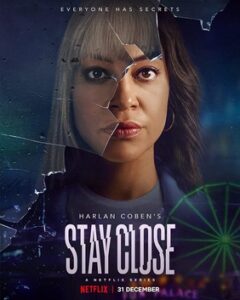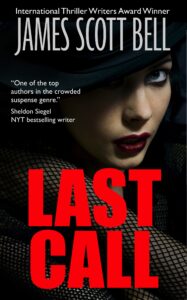 When I’m not reading or watching true crime or nature/wildlife documentaries, I search for net-streaming series based on novels. Why? Because they’re the next best thing to reading, if the series preserves the craft beneath the storyline. Harlan Coben’s STAY CLOSE on Netflix is the perfect example.
When I’m not reading or watching true crime or nature/wildlife documentaries, I search for net-streaming series based on novels. Why? Because they’re the next best thing to reading, if the series preserves the craft beneath the storyline. Harlan Coben’s STAY CLOSE on Netflix is the perfect example.
The Limited Series is split into eight episodes. In a novel the dramatic arc is split into four quartiles (25% each), called Parts.
- Part I: The Set Up: The first quartile (25%) of the story has but a single mission: to set-up everything that follows. We need to accomplish a handful of things, but they all fall under the umbrella of that singular mission. If we choose to show the antagonist, we only want to include jigsaw pieces of the puzzle. Most importantly, Part 1 needs to establish stakes for what happens to the hero after Part 1. Here in Part 1 is where the reader is made to care. The more we empathize with what the hero has at stake—what they need and want in their life and/or what obstacles they need to conquer before the arrival of the primary conflict—the more we care when it all changes. They’re like an orphan, unsure of what will happen next.
- Part II: The Response: This quartile shows the protagonist’s reaction to the new goal/stakes/obstacles revealed by the First Plot Point. They don’t need to be heroic yet. Instead, they retreat, regroup, and/or have doomed attempts at a resolution.
- Part III: The Attack: Midpoint information, awareness, or contextual understanding causes the protagonist to change course—to shift—in how to approach the obstacles. The hero is now empowered, not merely reacting as they did in Part II. They have a plan on how to proceed.
- Part IV: The Resolution: The protagonist summons the courage and growth to come up with a solution, overcome inner obstacles, and conquer the antagonist. They’re empowered, determined. Heroic.
In the Netflix series, every two episodes represent one quartile. Keep the dramatic arc in mind.
“If you say in the first chapter that there is a rifle hanging on the wall, in the second or third chapter it absolutely must go off.” —Chekhov
Chekhov’s Gun is the principle that every element in a dramatic work must either be relevant or removed, that we must not hold “false promises” out to readers. Consciously or not, we’re always loading Chekhov’s Gun. Every sentence is a rifle hung on the wall. Sooner or later, it will—must—go off.
Also known as setup and payoff. We’re always either setting up a future moment/scene or paying it off. Let’s see this principle in action…
*Spoiler Alert* of the first 15 minutes of Episode One
The HOOK takes place at a strip club called Viper’s. Fleeting images show a young man, drunk, stumbling outside and into the woods behind the club, in pursuit of…someone.
We don’t know who he’s chasing or why, so we’ll keep watching…
Then we’re in Suburbia and introduced to a mother of three, Megan, and her fiancé. That night, Megan, the bride-to-be, is the guest of honor at one of the tamest bachelorette parties in history.
At the party, a friend says, “It’s about time you two are getting married after sixteen years together.”
That one line of dialogue shows us a sliver of Megan’s backstory: the fiancé is also the father of her three children.
The same friend addresses the flock of women and our bride-to-be, Megan. “I know it’s not a traditional hen night. We’re way too classy for strippers, however, we do have—(man in a bathrobe enters the scene)—a model!”
The women shriek.
The camera pans out to show easels set up in a circle, and the women laugh, drink white wine, and attempt to draw. We like the bride-to-be. Megan’s fun, respectable, and clearly in love with her fiancé. Even with her wealth, we can easily relate to her.
After the fun drawing session, Megan chats with the same friend at the bar.
Friend: “I think it’s wonderful you and David are getting married after all this time.”
Megan: “We should have done it years ago.”
Friend: “Everyone else is splitting up, but you two just keep getting stronger.”
Through the short exchange we learn about her circle of friends and Megan’s relationship. A mental image of Megan takes shape. We like her even more. She’s a good, solid person. Reliable. Trustworthy. Faithful. Nice. We certainly wouldn’t want anything to happen to her—and that’s what good characterization is all about. We care about Megan. We’re living vicariously through her, and we’ll stick around to make sure she stays safe.
When Megan arrives home in a taxi—she would never drink and drive; we know this from her characterization—she finds a bottle of champagne on her front stoop. A card leans against the bottle. A card addressed to Cassie [Motivation]. Who’s Cassie? The card terrifies Megan, evident by her silent gasp [Reaction]. Camera zooms in on the name again [Motivation], then on Megan, whose blank stare and parted lips shows she’s clearly terrified [Reaction]. She whirls around, her gaze scanning the dark road, the envelope gripped tight between her fingers.
In the envelope, a card portrays a bride and groom waltzing. With no note inside, the card itself acts as a direct threat to Megan. But because we have no idea why it’s a threat or who Cassie is, we’re glued to the screen.
A lack of information is often more powerful than the explanation.
Megan races into the house to check the security footage. But the person who left the card is wearing a hoodie. The camera doesn’t help her identify the interloper. (Rising tension, enhanced stakes)
This scene looks a lot like the first pinch point, doesn’t it? But it’s too early. Therefore, the placement indicates it’s the Inciting Incident.
Inciting Incident *Optional*: Not every story has to have an Inciting Incident in the way I use the term. Some call the Inciting Incident the First Plot Point. I refer to it as a separate Milestone, a foreshadowing of the First Plot Point. It can even be an entirely different event, one that relates to the main plot, but it’s a false start. A tease.
New Scene, New POV Character.
This time, a middle-aged detective, DS Michael Broome, and his female partner, DC Erin Cartwright, are assigned the missing persons case of a 20-year-old named Carlton Flynn. The much-younger superior, DCS Brian Goldberg, tells the detectives there’s already been a hit on Flynn’s car.
Camera zooms in on the car so the viewer will remember what it looks like (setting up a future scene).
Carlton has been missing about 48 hours, and this seems to aggravate DS Broome, probably because he has a big enough workload already. Besides, Carlton’s an adult who’s probably out partying somewhere.
Now, DCS Goldberg orders DS Broome to speak with the victim’s father, who is well-connected with friends in the department. The decades between DS Broome and DCS Goldberg add instant micro-tension. The viewer doesn’t need to be told anything. Instinctively, we know these two will butt heads at some point. It’s bound to happen, right? This age-gap adds another layer of intrigue, more story questions, and enhances Broome’s characterization i.e., for now, he’s on his best behavior.
In the driveway at the Flynn residence, Broome exists the car and says to his partner, “Erin, that’s weird.”
Notice how Coben purposefully leaves out the conversation preceding this remark? By doing so, he raises more story questions and piques curiosity.
“It’s not weird,” DC Cartwright says as they stroll toward the front door. “I’m not asking for details.”
“Good, ’cause you’re not getting them.”
“Just tell me, was she nice? ’Cause that’s not details. You deserve a nice woman.”
DS Broome admits, “Yes, she was nice.”
“Good, good, I’m glad.”
“A bit eager, maybe.”
“Eager,” she echoes, nodding.
“Keen to please. Like a Labrador.”
This banter is light, witty, and fun. We instantly like these two, and their partnership (characterization).
Mr. Flynn tells the detectives how worried he is, how his son would never wander off without a word to anyone. The stepmother is much younger than he, and they admit Carlton and the new Mrs. Flynn didn’t always see eye-to-eye. But, Mr. Flynn adds, nothing that would make him leave home.
When the stepmother goes to find a photograph of Carlton, Mr. Flynn asks the detectives if they have kids.
DC Cartwright: Two-year-old.
DS Broome: No. My ex-wife didn’t want them.
Broome’s is a bold statement. We find out why later. For now, we learn he’s divorced, adding another layer of characterization, but it also raises story questions. Did he want kids? The dialogue indicates he did, but we can’t be sure.
See how Coben slips in backstory and keeps the viewer engaged? Every word is strategically placed for a reason. Every sentence/line of dialogue has a purpose.
“He hasn’t been on social media,” the father says, “Nothing. It just stopped April sixteenth.”
The date startles DS Broome. “April sixteenth? I thought Carlton went missing on the seventeenth.”
“No,” Mr. Flynn says. “The seventeenth is the day we realized something was wrong.”
“Right. Huh.” DS Broome pauses. “Does the name Stewart Green mean anything to you?”
DC Cartwright stares at her partner like, Why would you ask him about Stewart Green?
We wonder why, too. Again, raising story questions, dragging us along, forcing us to continue.
When the stepmother returns with a photo of Carlton, he’s the guy from the HOOK. Remember the drunk dude who stumbled into the woods in pursuit of…someone? That’s Carlton Flynn! Not only has Coben paid off the Hook, but he’s also raised new story questions. What happened to Carlton Flynn? Why was he in the woods? Who was he chasing?
When we answer one question, we must raise another—all to set up the First Plot Point or another pivotal Milestone.
While walking back to the car, DC Cartwright says, “Stewart Green?”
“Seventeen years to the day.”
DS Broome’s dialogue adds a sliver of backstory AND implants story questions in our mind: How do these two missing people align? Or is he obsessed with an old case?
“Let it go.”
“Erin, it’s a feeling I’ve got.”
“You see connections everywhere.” (characterization detail)
“I see connections where there are connections,” DS Broome says. “It’s called being a good cop.” (characterization detail)
“Oh, don’t. The only case that’s ever beaten you. (backstory) I call that being an egomaniac.”
“Ego?” DS Broome is visibly upset, tone rising with anger. “I let them down. His family, his wife, they were destroyed. I told them I find him.” (backstory, characterization detail: he is haunted by this old case)
Snide and cold, DC Cartwright smirks. “Did sleeping with her soften the blow?” (backstory, tension)
“That was years later, as you well know.” Over the roof of the car, Broome pouts his bottom lip. “And I was brokenhearted.”
“For the record, I did want kids. Just—”
Broome fills in the blank. “Not with me.”
Bam! Those last two lines of dialogue bring meaning to all the dialogue that came before it, including why DS Broome thought it was weird to share details about his date. These two are a lot more than partners. They were married! Which raises even more story questions. Did he cheat on Erin with Stewart Green’s wife? Is that why they divorced? Give us details!
But Coben is far too clever to reveal all the juicy tidbits at once. We’ll have to wait, and keep watching…
“Act first, explain later.” —James Scott Bell
The final POV character is a paparazzi-for-hire named Ray Levine, snapping photos outside a bar mitzvah for a young celebrity, who winds up kicking Ray in the shin. The bodyguard ushers the child star into the venue. Moments later, we learn through dialogue that the bodyguard and Ray are buddies. In fact, he’s the one who hired Ray to take photos.
Coben opens his 2012 thriller of the same title with Ray. Let’s take a look…
Sometimes, in that split second when Ray Levine snapped a picture and lost the world in the strobe from his flashbulb, he saw the blood. He knew, of course, that it was only in his mind’s eye, but at times, like right now, the vision was so real he had to lower his camera and take a good hard look at the ground in front of him. That horrible moment—the moment Ray’s life changed completely, transforming him from a man with a future and aspirations into this Grade-A loser you see in front of you—never visited him in his dreams or when he sat alone in the dark. The devastating visions waited until he was wide-awake, surrounded by people, busy at what some might sarcastically dub work.
The vision mercifully faded as Ray continuously snapped pictures of the bar mitzvah boy.
Look at how many story questions he’s raised in the first paragraph. What’s the blood about? Did he kill someone? What happened to this man? Coben also forces us to care about Ray. The poor guy suffers from horrible visions. At the same time, we wonder why. We need answers! And so, we’ll keep reading.
Coben shuffled the POVs for the Netflix series, and it’s just as effective.
After we meet Ray at the bar mitzvah, he treks home through the seedier part of town. Someone slams him over the head and steals his camera, making it appear like someone connected to the child star mugged Ray. Coben wants us to make this assumption, so when we find out why he’s mugged in the payoff scene, it’s a surprise.
Employing all these techniques is how to force the reader to keep flipping pages. Or, in this case, binge the whole series.
Have you read STAY CLOSE? Have you seen the Netflix series? If you haven’t, at least watch the first episode (or even the first 15 minutes!) to see how this plays out on the screen, and witness a master storyteller at work.
 I keep all my writing stuff in a dedicated folder on my Mac. I worked really hard to come up with a clever name for this folder. I call it “Writing.”
I keep all my writing stuff in a dedicated folder on my Mac. I worked really hard to come up with a clever name for this folder. I call it “Writing.”
 When I’m not reading or watching true crime or nature/wildlife documentaries, I search for net-streaming series based on novels. Why? Because they’re the next best thing to reading, if the series preserves the craft beneath the storyline. Harlan Coben’s STAY CLOSE on Netflix is the perfect example.
When I’m not reading or watching true crime or nature/wildlife documentaries, I search for net-streaming series based on novels. Why? Because they’re the next best thing to reading, if the series preserves the craft beneath the storyline. Harlan Coben’s STAY CLOSE on Netflix is the perfect example.

